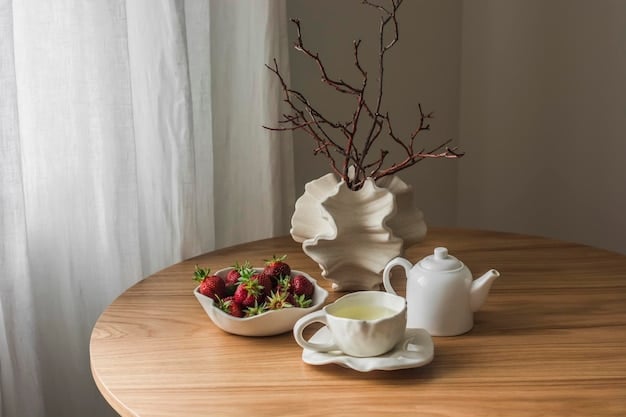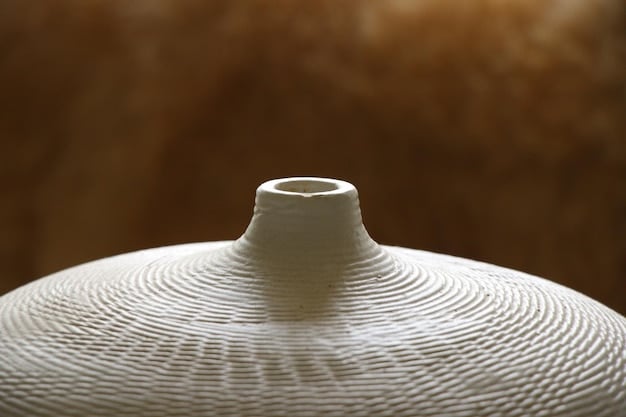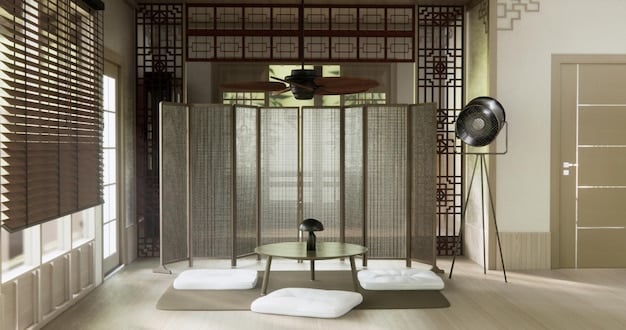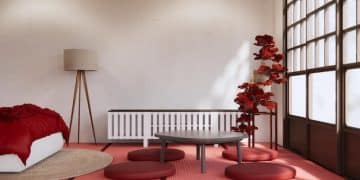The Influence of Korean Art on US Design: Key Elements to Know

The influence of Korean art on contemporary US design is evident in its minimalist aesthetics, emphasis on natural materials, and incorporation of traditional motifs, offering a unique and harmonious blend of cultures.
The interplay between cultures often sparks innovation and redefines aesthetic boundaries. Today, we delve into the influence of Korean art on contemporary US design: key elements to know, exploring how the Land of the Morning Calm has subtly reshaped American aesthetics.
Understanding the Roots: Traditional Korean Art
To truly appreciate the impact of Korean art on contemporary US design, we must first understand its foundations. Traditional Korean art is characterized by a deep respect for nature, an emphasis on simplicity, and a profound connection to its cultural heritage.
Key Characteristics of Traditional Korean Art
Traditional Korean art is not just about aesthetics; it’s a reflection of the values and beliefs deeply ingrained in Korean culture. Key traits include a harmonious blend of functionality and beauty rooted in nature.
- Emphasis on Nature: Korean art frequently incorporates natural elements like mountains, water, and flora, symbolizing harmony and balance.
- Minimalist Aesthetics: Simplicity and clean lines are central, avoiding excessive ornamentation.
- Use of Natural Materials: Traditional materials like wood, paper, and clay are preferred to maintain a connection with nature.
These foundational elements have laid the groundwork for contemporary interpretations, bridging the gap between the past and the present.
The Rise of Korean Minimalism in US Interiors
One of the most significant ways Korean art has influenced US design is through the embrace of minimalism. This approach, characterized by simplicity and functionality, has found resonance among American designers seeking refined aesthetics.

Embracing Simplicity and Functionality
Korean minimalism prioritizes functionality and eliminates unnecessary clutter. This is reflective of a core belief – a focus on essential elements that promote tranquility and mental clarity.
The use of negative space is an important aspect of this minimalistic design approach. When you eliminate unnecessary ornamentation, the remaining elements can deliver a more profound impact.
Natural Materials: A Korean Influence on US Sustainable Design
Sustainability and eco-consciousness are increasingly important in US design. Korean art’s emphasis on natural materials aligns perfectly with this trend, bringing nature indoors and promoting a healthier living environment.
Designers are now incorporating authentic and sustainable materials. This offers not just aesthetic appeal but a deeper connection to the environment, creating spaces that are both welcoming and ethically responsible.
Color Palettes: Earth Tones and Muted Shades
Color plays a crucial role in design, and Korean art influences US interiors through its use of earthy and muted shades. These colors create a sense of calm, tranquility, and connection to nature, in contrast to the bolder, more vibrant hues often associated with Western design.
Earthy tones like ochre, beige, and deep greens are often incorporated into interior design. They reflect traditional Korean architecture and landscapes. Meanwhile, the use of muted blues or soft grays add a sense of serenity that aligns with the minimalist style.
Traditional Motifs: Subtly Integrated into Modern Spaces
While overt displays of traditional Korean motifs may seem out of place in modern US designs, these patterns and symbols are often subtly integrated to add depth and cultural richness. This approach allows designers to respect heritage while embracing contemporary aesthetics.
Common Korean Motifs and Their Meanings
- Crane: Symbolizes longevity, peace, and happiness.
- Mountains: Represents stability, strength, and connection to nature.
- Plum Blossoms: Conveys resilience and perseverance, as they bloom even in harsh winter conditions.
Incorporating these motifs through textiles, artwork, or even architectural details can add a layer of sophistication and storytelling to a space.

Furniture Design: Low Profiles and Clean Lines
Distinct Korean-inspired furniture design is characterized by low profiles, clean lines, and a focus on functionality. These elements contribute to a sense of openness and visual harmony, making spaces feel more spacious and less cluttered.
The furniture is traditionally understated, letting the natural materials and design speak for themselves and reflecting the values of minimalism and simplicity. This has a huge influence on contemporary US design which emphasizes balance, connection, and environmental responsibility.
The Enduring Appeal: A Harmonious Blend
The influence of Korean art on contemporary US design is not just a passing trend; it is a testament to the enduring appeal of simplicity, nature, and cultural depth. By incorporating key elements of Korean aesthetics, US designers can create spaces that are both beautiful and meaningful.
Ultimately, integrating simplicity, nature, unique color palettes and motifs from Korean art, yields harmonious spaces that resonate on a deeper level and promotes a more balanced and enriching life experience for occupants.
| Key Element | Brief Description |
|---|---|
| 🌿 Minimalism | Emphasizes simplicity and functionality, reducing clutter. |
| 🎨 Earth Tones | Uses muted shades to create calm and natural ambiance. |
| 🪵 Natural Materials | Focuses on wood, paper, and clay for sustainability. |
| 🕊️ Traditional Motifs | Integrates symbols like cranes and plum blossoms subtly. |
Frequently Asked Questions
▼
Korean minimalism is an aesthetic approach that emphasizes simplicity, functionality, and a lack of clutter, reflecting traditional Korean values and beliefs in harmony and balance.
▼
Nature plays a central role in Korean art. Mountains, water, and flora are commonly depicted, symbolizing harmony and balance. The use of natural materials further connects art with the environment.
▼
Korean-inspired designs often feature earth tones and muted shades. Ochre, beige, deep greens, and soft grays are common, creating a sense of calm and connection to nature.
▼
Common Korean motifs include the crane (symbolizing longevity), mountains (representing stability), and plum blossoms (conveying resilience). These are often subtly integrated into modern designs.
▼
Incorporate Korean design by using minimalist decor, choosing furniture with clean lines, using earth-toned color palettes, and adding subtle touches of traditional motifs through artwork or textiles.
Conclusion
In conclusion, the integration of Korean art elements into contemporary US design showcases a beautiful fusion of cultural influences. Embracing minimalism, natural materials, and traditional motifs can transform spaces into serene, sophisticated environments.





